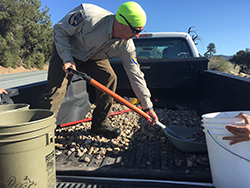



California’s drought emergency was officially declared to be over last year, but its deleterious impact on fish habitat is still being felt in many parts of the state -- especially in arid parts of Southern California. In order to help offset these effects at one site in northern San Diego County, CDFW biologists and other staff recently toiled to create spawning beds for rainbow trout.
The Sweetwater River is a second-order stream located within Cuyamaca Rancho State Park. The underlying rock is granite, which, as it erodes, creates sand that accumulates in the low-gradient portion of the river. Previous surveys in the Sweetwater River revealed a lack of high-quality spawning habitat for the rainbow trout population, which was reduced by 70 to 80 percent during the recent drought.
Seeing an opportunity to restore habitat to this waterway, South Coast Region fisheries biologists came up with a plan to place suitable materials into Sweetwater for the rainbow trout to use for new spawning grounds. Beginning on March 20, CDFW Environmental Scientist Russell Barabe, scientific aids Joseph Stanovich and Ken Sankary and volunteer Mark Berlin worked in the hot sun and dry conditions to rehab the streambed. Using a nearby dry stream channel, the team shoveled hundreds of pounds of rocks and materials through mesh screens to remove fine sediment and sand and clean the rock, called cobbles, to make them ready for placement into Sweetwater River. All the rock had to be moved one bucket at a time and poured into pool tailouts (the downstream end of a pool where the water gradually shallows) to create spawning beds about three feet square for rainbow trout.
Though similar work has been done in northern California – specifically two larger-scale projects in the American and Sacramento rivers, which served as the inspiration for this project – it had never been done in this small a stream before.
This small but important project could increase the spawning success of a drought-reduced population in a stream with easy public access. If successful, this project could be used as a model for future habitat restoration activities in other small trout streams. The fisheries team’s work is an example of how our scientists put the mission of CDFW – to conserve California’s fish and wildlife resources for the use and enjoyment of the public – into action.
CDFW Photos. Top Photo: CDFW Scientists hauling buckets of rocks to create spawning beds for rainbow trout.
# # #